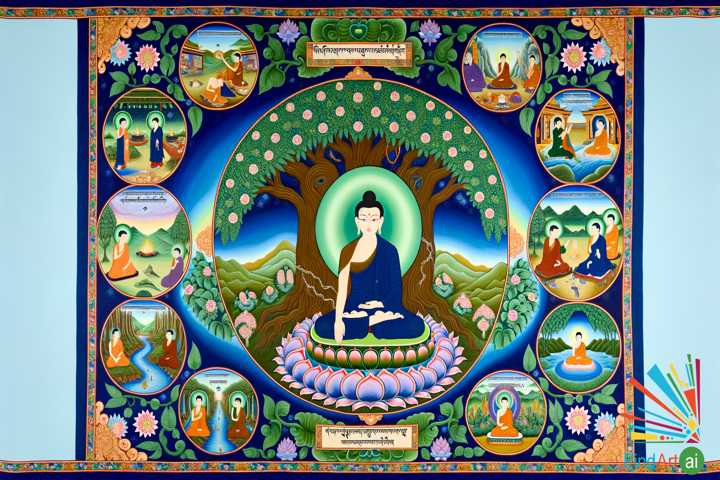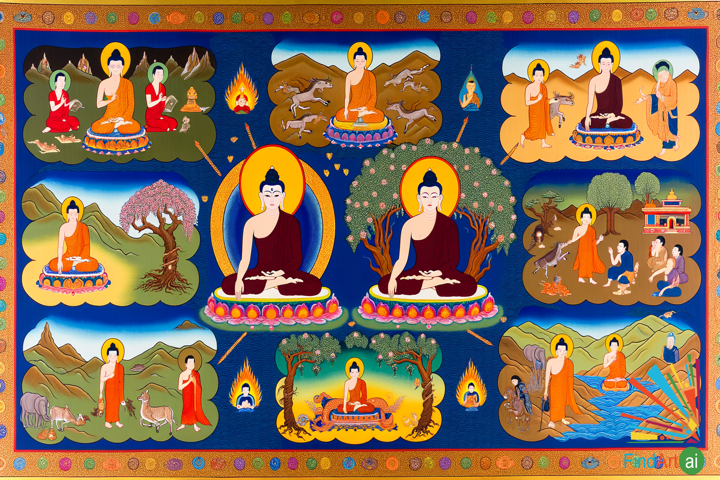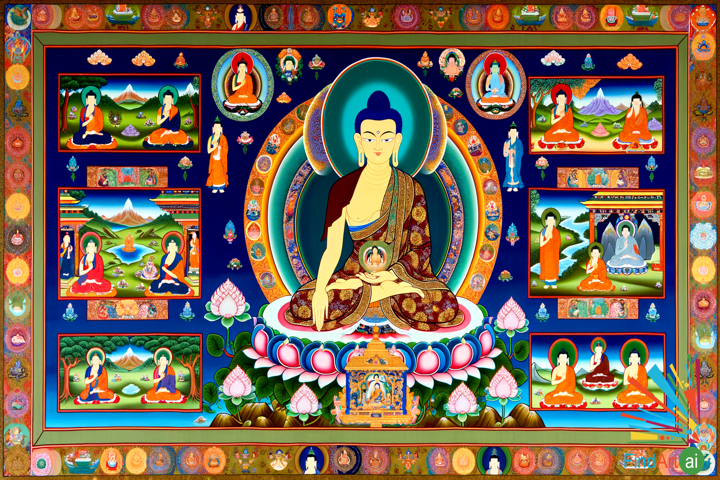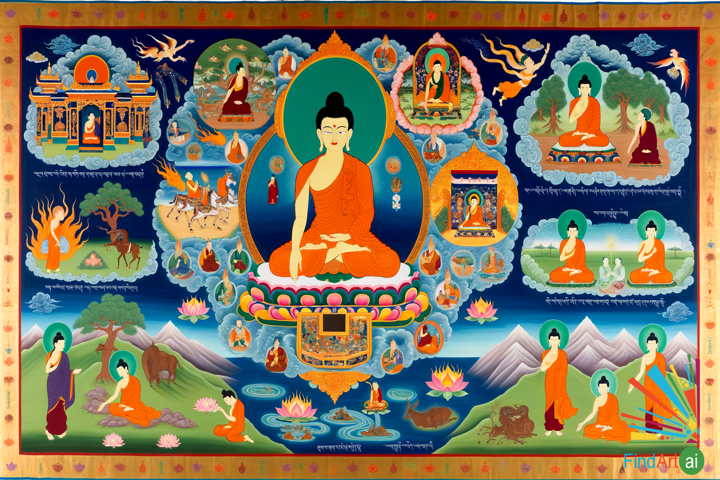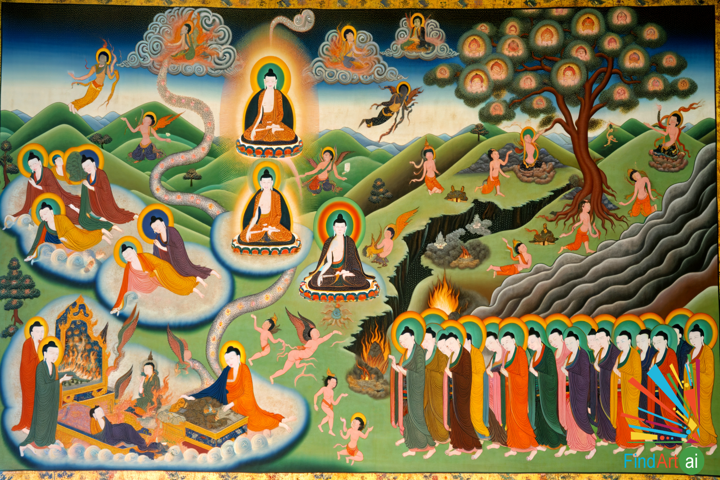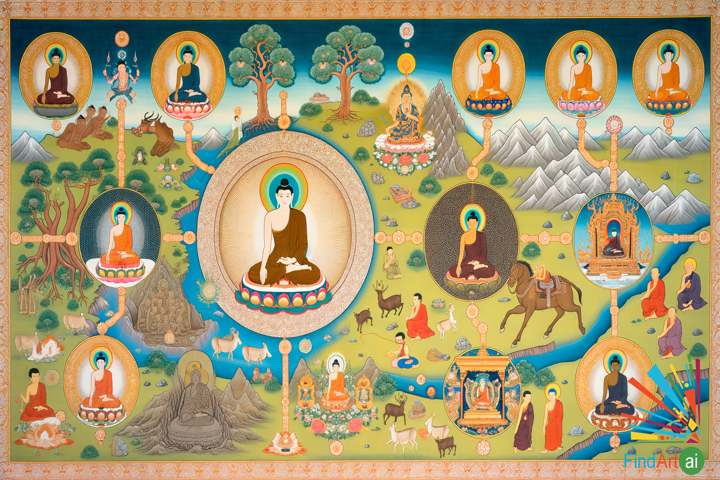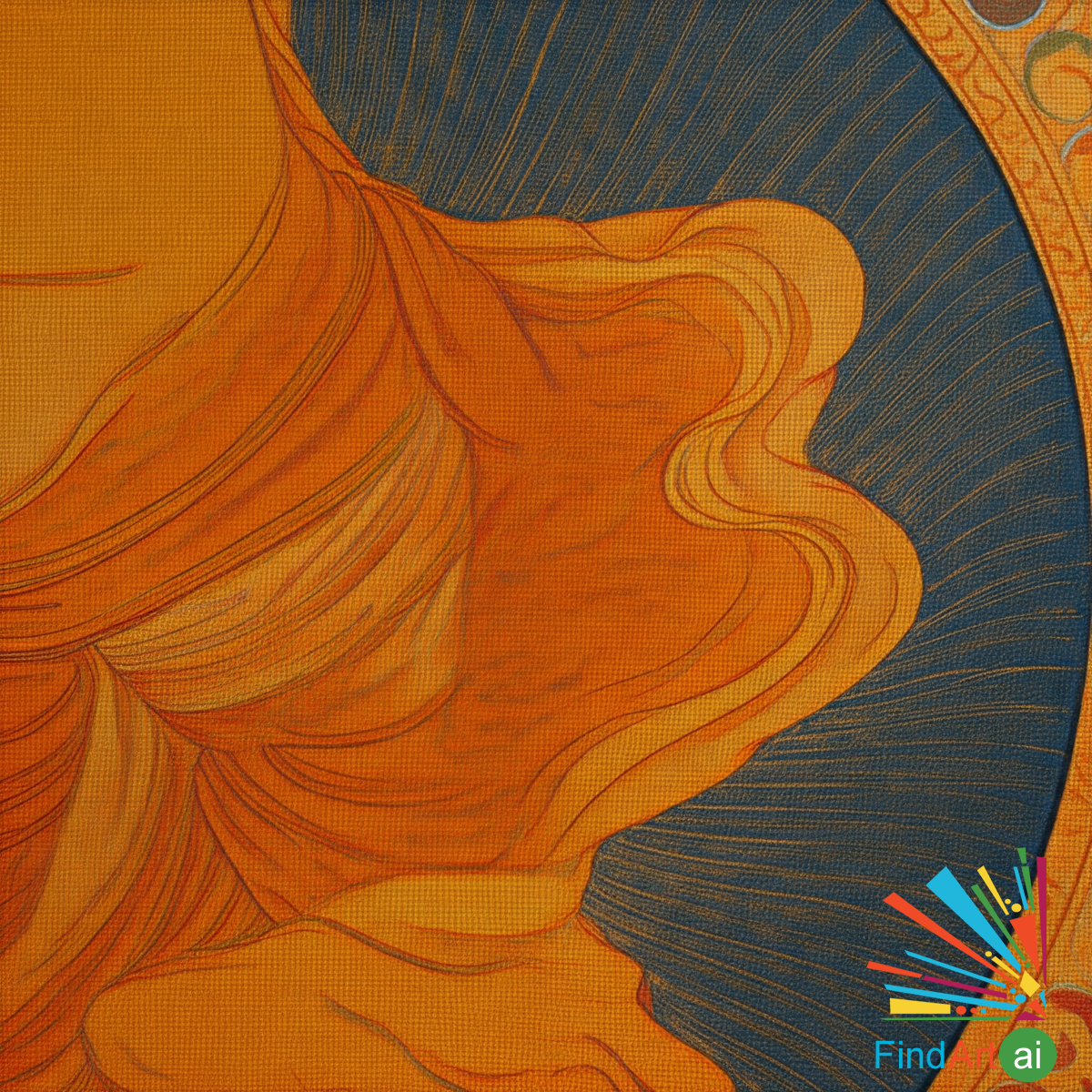
Tibetan Thangka Paintings with Life of the Buddha Theme
Tibetan Thangka Paintings with the Life of the Buddha theme are intricate, spiritual works of art that depict significant events in the life of Siddhartha Gautama, from his birth to his attainment of enlightenment and teachings as the Buddha. Thangkas are traditionally painted on fabric or cotton and are used as teaching tools, aids for meditation, and objects of devotion within Tibetan Buddhism. These paintings are highly symbolic, with detailed compositions that focus on both the historical and spiritual journey of the Buddha.
Key Characteristics of Tibetan Thangka Paintings with the Life of the Buddha Theme
- Detailed Narrative Depictions
- Thangkas often tell the story of the Buddha’s life through a series of symbolic and detailed vignettes, highlighting key moments such as his birth in Lumbini, renunciation of worldly life, enlightenment under the Bodhi tree, and his first sermon at Sarnath.
- Example: A Thangka might show the young Buddha-to-be, Siddhartha, emerging from his mother’s side at birth, a common scene representing his divine origins.
- Central Figure of the Buddha
- The central figure in the Thangka is usually the Buddha in a specific pose (mudra) or aspect, often seated in meditation or teaching, surrounded by scenes that depict the significant stages of his life.
- Example: The Buddha may be depicted in the Bhumisparsha mudra, the "earth-touching" gesture that represents his calling the earth to witness his enlightenment.
- Symbolism and Iconography
- Thangka paintings are filled with Buddhist symbols, such as lotuses (representing purity and spiritual awakening), bodhi trees, animals, and celestial beings. These symbols help convey the spiritual significance of the events in the Buddha’s life.
- Example: The Bodhi tree under which Siddhartha attained enlightenment is often depicted prominently, symbolizing wisdom and enlightenment.
- Structured Composition
- Thangkas typically follow a highly structured, hierarchical composition. The main figure of the Buddha is often surrounded by smaller narrative scenes or figures, arranged symmetrically to create balance and harmony.
- Example: A Thangka of the Buddha’s life might feature him at the center, surrounded by smaller depictions of key events like the Great Renunciation (when he left his princely life) and his encounter with Mara, the tempter.
- Vivid Colors and Fine Detail
- Tibetan Thangkas use bright, vivid colors like gold, red, blue, and green, applied with fine, precise brushwork. The colors are symbolic: gold represents enlightenment, blue symbolizes infinity and wisdom, and red symbolizes strength and transformation.
- Example: In a scene depicting the Buddha’s enlightenment, the radiant glow around him is often painted in gold, emphasizing his divine wisdom and spiritual victory.
- Spiritual and Meditative Purpose
- Thangka paintings are not just visual representations but are intended for meditation and contemplation. They serve as spiritual tools to guide practitioners in their understanding of the Buddha’s teachings and the path to enlightenment.
- Example: Monks or practitioners may meditate on a Thangka depicting the Buddha’s teachings, focusing on the various events in his life as a way to reflect on the Dharma (Buddhist teachings).
- Narrative Scenes in Context
- The life of the Buddha is depicted not only as a series of historical events but as spiritual milestones on the path to enlightenment. Thangkas may also include figures like bodhisattvas, disciples, or deities who play a role in Buddhist cosmology.
- Example: A Thangka of the Buddha’s life might show his disciples, Sariputra and Maudgalyayana, at his side during key teachings, emphasizing the transmission of wisdom.
- Emphasis on Enlightenment and Teaching
- The focus of these Thangkas is often on the Buddha’s enlightenment and the subsequent spreading of his teachings. The First Sermon at Deer Park, where he taught the Four Noble Truths, is a common subject.
- Example: A painting might show the Buddha teaching a group of disciples in Deer Park, with the Wheel of Dharma (symbolizing the teachings) at the center, marking the beginning of his spiritual mission.
Common Themes in Tibetan Thangka Paintings with the Life of the Buddha
- Birth and Early Life
- Thangkas often depict Siddhartha’s miraculous birth in Lumbini, where he is said to have taken seven steps immediately after being born, and his early years as a prince, surrounded by luxury and protection from the outside world’s suffering.
- Example: A painting might show the young prince’s encounter with old age, sickness, and death, pivotal moments that led to his renunciation of worldly life.
- The Great Renunciation
- The moment when Siddhartha leaves behind his royal life and sets out on a spiritual journey is another key subject. This marks his decision to seek enlightenment and end suffering.
- Example: A Thangka might show Siddhartha cutting his hair and discarding his royal garments as he begins his quest for spiritual truth.
- Enlightenment
- The central moment of the Buddha’s life is his enlightenment under the Bodhi tree. Thangkas emphasize the Buddha’s victory over the temptations of Mara, the embodiment of desire and death, highlighting his spiritual strength.
- Example: The scene might show Mara’s army trying to distract Siddhartha, with the Buddha sitting calmly in meditation, unshaken by their attempts.
- Teaching and the Spread of Buddhism
- After enlightenment, the Buddha’s teachings are a central focus of Thangka paintings. His first sermon at Sarnath, the teaching of the Four Noble Truths, and other moments of instruction are often depicted.
- Example: The Buddha teaching his disciples under the Bodhi tree might be shown, with radiating light and symbols of wisdom surrounding him.
- The Parinirvana (Passing of the Buddha)
- The Buddha’s death, known as Parinirvana, is another important subject. It represents his final release from the cycle of birth, death, and rebirth. Thangkas depict him lying on his side, surrounded by grieving disciples and bodhisattvas.
- Example: A Thangka might show the Buddha in a peaceful, serene state, with monks and followers gathered in mourning, but with symbols of the Buddha’s eternal wisdom present.
Thangka Art: The Enlightened Journey of Buddha from Birth to Parinirvana
"The Enlightened Journey: Life of the Buddha" prompts a captivating Tibetan Thangka that captures Si...
Buddha's Journey: A Vibrant Thangka Depicting Siddhartha's Path to Enlightenment
"The Enlightened Journey: A Thangka of the Buddha's Life" is a vibrant Thangka painting that beautif...
Siddhartha's Enlightenment: A Vibrant Thangka Journey Through the Buddha's Life
"The Enlightened Journey of Siddhartha" Thangka captures the life of the Buddha through intricate sc...
Journey to Enlightenment: A Thangka of Buddha's Life in Vivid Colors and Symbolic Motifs
"The Enlightened Journey: A Thangka of the Buddha's Life" is a Tibetan Thangka painting that illustr...
Tibetan Thangka: The Enlightened Journey of Buddha from Birth to Parinirvana
"The Enlightened Journey: Life of the Buddha" is a Tibetan Thangka painting depicting Siddhartha Gau...
Tibetan Thangka: Buddha's Life from Birth to Enlightenment in Vibrant Detail
"The Enlightened Journey: Life of the Buddha" is an exquisite Tibetan Thangka painting that vividly ...

